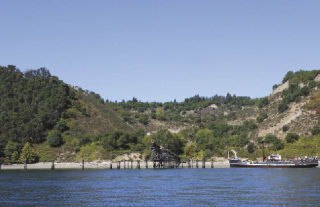The Seattle-King County Health Department is reviewing Glacier Northwest’s expansion plans on Maury Island to determine if the mining corporation will need to establish a landfill for the arsenic-laced soil it plans to remove.
The decision to look into the issue came after anti-Glacier activist Amy Carey and state Rep. Sharon Nelson met with the head of the agency, Dr. David Fleming, to press their case that a landfill designation is in order — a move that could dramatically increase the costs and complexity of the sand and gravel excavation plan. It also comes on the heels of a decision by the county’s Department of Development and Environmental Services (DDES) that such a permit is not needed for the corporation to move forward.
In a March letter to Carey, DDES head Stephanie Warden said Glacier’s plans to create “a containment cell” for the contaminated soil will be sufficient to protect the Island’s sole-source aquifer, the source for most residents’ drinking water. The containment cell, lined on the bottom and covered on the top, will be reviewed by state and county officials to ensure it adequately protects Vashon’s water quality, Warden added in her letter.
The health department, however, has agreed to take a look at the issue, despite the decision by DDES. A spokesperson for the department would say little about the health department’s review.
“Essentially, what we can say today is that we are examining the gravel mining issue from a public health orientation and are carefully reviewing options to see what the best course of action is from a public health perspective,” Hilary Karasz said in an e-mail to The Beachcomber. “We will have more specific information in the upcoming week or two.”
The issue comes at a critical time for the project, which some speculate could be close to receiving the final green light it needs to move forward. According to Glacier, if it receives an OK from the U.S. Army Corps of Engineers — which is expected to soon release its final environmental assessment — and a lease from the state Department of Natural Resources, it could begin building the controversial barge-loading pier off the eastern flank of Maury Island as early as this August.
The company can only build during so-called “fish windows,” the time when few migratory fish are found in central Puget Sound. Pete Stoltz, permit coordinator for Glacier, said he believes the company could have the last permits in place in time to take advantage of the fish window this fall and winter.
“We’re at a point where we have to prepare ourselves to move forward, and we’re doing that,” he said.
Carey, who heads Preserve Our Islands (POI), a grassroots organization fighting Glacier’s proposed expansion, vehemently disagreed with Stoltz’s assertion. Should Glacier get approval from the Corps, POI will take the matter to U.S. District Court where it will seek an injunction to stop the project in its tracks. POI is also appealing one of the state permits Glacier has already received.
“I think Glacier has a heck of a uphill battle ahead of them,” Carey said.
Glacier, owned by a Japanese-based conglomerate, first announced plans to dramatically increase excavation at its 235-acre site 10 years ago. According to its initial plans, it could extract as many as 7.5 million tons a year from the now-quiet stretch of beach just north of Sandy Shores. The company has since put the number at around 1.5 million tons.
A lynchpin in the expansion is Glacier’s plan to replace the dilapidated pier that now extends about 90 feet into the water with a 400-foot, state-of-the-art barge-loading pier. The pier would enable the company to deposit the sand and gravel directly onto 40-ton barges, sidestepping the expensive costs of trucking sand and gravel off-Island.
Though the battle has waged for a decade, Glacier has won several of the latest rounds — including a recent decision by the state Supreme Court to not review the issue. The Legislature, despite Nelson’s effort and those of other environmentally oriented lawmakers, also chose not to pass bills that could have slowed or even halted the controversial project.
Even so, Carey remains optimistic that fierce opposition to the project — among not only many Islanders but also environmental groups throughout the region — will ultimately carry the day. Her and Nelson’s meeting with Fleming two weeks ago was particularly encouraging, she said.
“He’s looking actively and seriously at this,” she said. “I think they recognize that there are some things they need to investigate and fully examine, and that’s what they’ve told us they’re doing.”
According to Carey, the issue is fairly clear-cut. An early-on Environmental Impact Statement crafted by King County stated that Glacier’s disposal of contaminated soil on the site is solid waste, and the disposal of solid waste constitutes a landfill subject to regulations in the county’s health code, she said. What’s more, the county’s revised critical areas ordinance, updated in 2005, bans landfills in what’s called a “ critical aquifer recharge area,” something the entire Island has been designated, Carey said.
“We’re not talking about a pile of banana peels or inert waste,” she said. “We’re talking about something with real health risks.”
But Warden, with DDES, said the changes to the county’s critical areas ordinance came after Glacier first sought the necessary permits from the county to excavate sand and gravel, and thus the revised ordinance” does not apply to the onsite containment area.”
Stoltz agreed, adding that because the company is not taking contaminated soil off-site, it does not amount to a landfill. “It’s a containment facility,” he said.
But Carey said the EIS clearly called the materials solid waste in need of disposal and that the health department — not DDES — has jurisdiction on this matter.
“Why would an agency go through great contortions not to protect public health?” she added. “That would be pretty astonishing and the legal ramifications pretty huge.”



